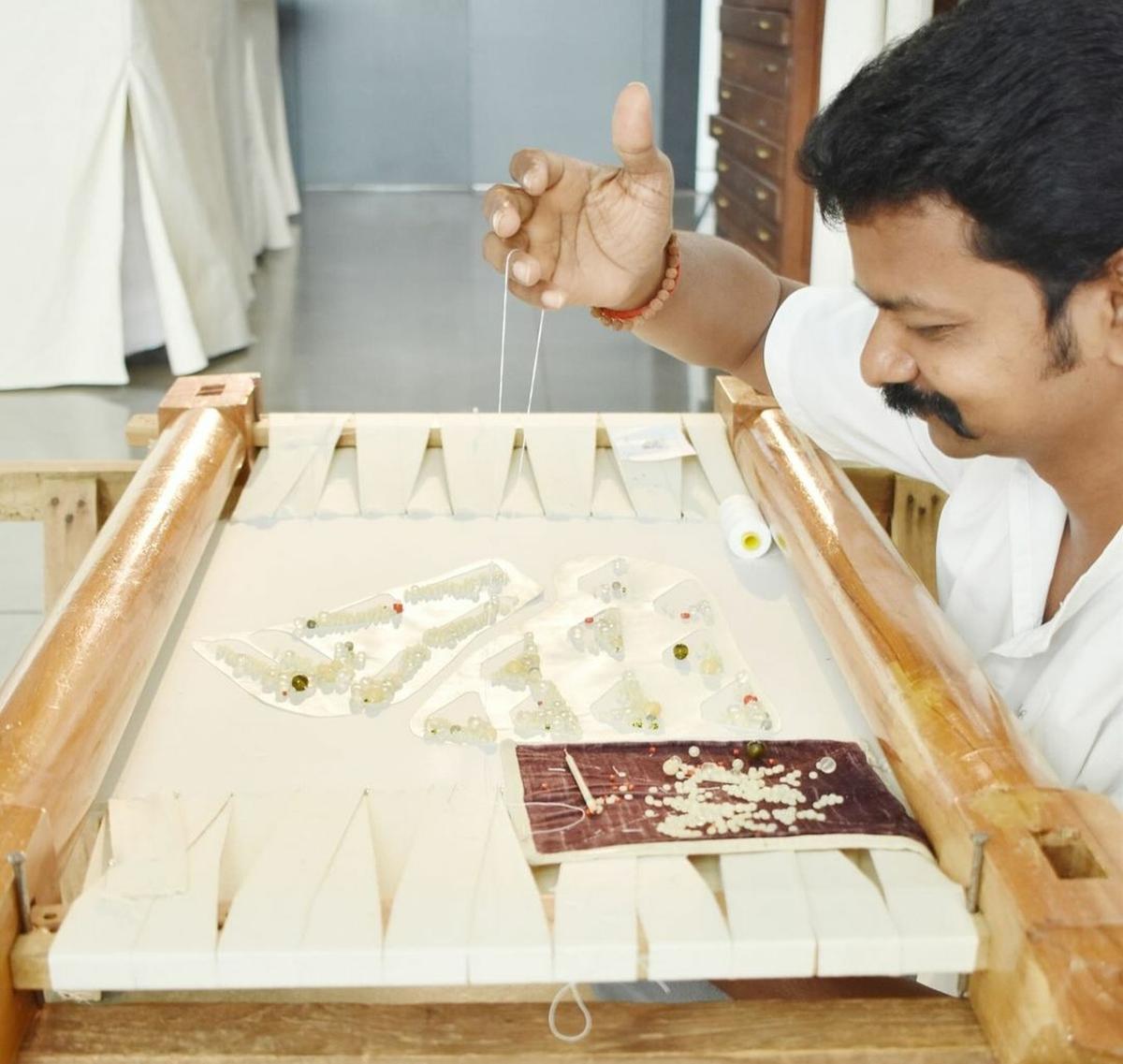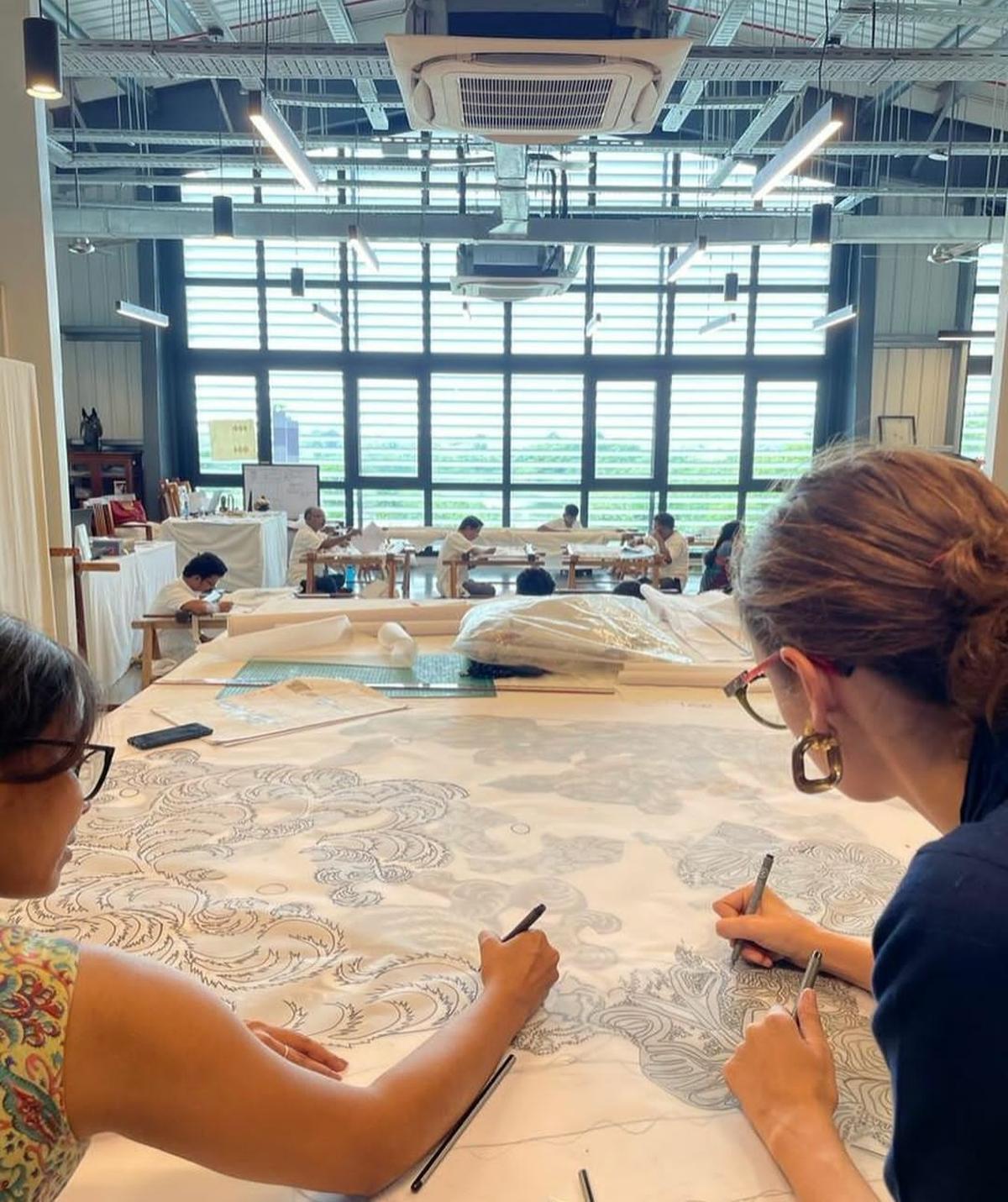Vastrakala’s intricate hand embroidery is part of private homes in France, the Opera de Monte Carlo in Monaco, and even the refurbished throne of French emperor Napoleon. Now, the artisans are expanding their repertoire — with collaborations. The latest addition is textile that resembles stained glass, jointly created by French multidisciplinary designer Victoire de Brantes and the embroiderers during a four-month residency.
“At Vastrakala [co-founded by French entrepreneur Jean-François Lesage], we have had regular interventions with artists, notably painters, but this was our first real artistic residency,” says co-founder and managing director Malavika Shivakumar. In collaboration with Villa Swagatam, a platform for cultural exchanges between Indian and French artists, the residencies are aimed at creating new forms of embroidery and developing fresh products for the Chennai-based embroidery atelier.
De Brantes with mentor Jean-François Lesage
De Brantes was particularly drawn to Vastrakala because of her familiarity with Lesage Interieurs, which works with museums, architects, designers, and upholsterers globally. “The synergy between the two cultural landscapes appealed to me greatly,” shares the 25-year-old, who spent her childhood between South India and the south of France, and was greatly inspired by traditional Indian crafts.
“A typical day, which started at 9 a.m., was filled with creative drawings, tracking the progress of samples and prototypes, and observation and exploration of materials and archives,” says De Brantes, who was mentored by Lesage, the artistic director, and worked with a dedicated team of 15 artisans. Her days followed a natural rhythm, she adds, “with tea and lunch breaks with the staff, and traditional rituals, including the weekly puja every Friday”.

Embroiderer at Vastrakala
Lesage’s language of embroidery
For De Brantes, embroidery was a new medium. Staying at the premises — a massive 45,000 sq. ft. atelier near Sriperumbudur employing close to 200 craftspeople — meant she could spend all her time learning the techniques. “Under Lesage’s mentorship, I delved into the language of embroidery. Drawing from technical references, archival insights, and diverse inspirations, we cultivated a shared creative approach that fostered a collaborative atmosphere, enabling the embroiderers, tailors, and myself to collectively shape the project,” she says.
The objective was to create a new form of embroidery that incorporated functionality and beauty. “The ‘new’ aspect of the design development lies in the modular nature of the embroidery, traditionally known to be one final composition,” she states. “Here, various panels are crafted to come together, forming different narratives such as curtains and wall dividers.” This approach offers flexibility and versatility in creating diverse configurations to suit different spaces and purposes.
“The modular embroidered panel Victoire created plays with the idea of filtering natural light [with the opaque and transparent areas completing each other]. The result appears as a textile stained glass,” explains Lesage, whose interest in the Indian craft was ignited in the 1980s. “Her immersion with the artisans let her build her own comprehension of techniques, materials and their potential use, transforming traditional ways into her own language.”

De Brantes at Vastrakala
Contemporary sensibilities
The residency helped the embroiderers, too. “With design, it is not about invention, but about reinterpretation,” says Shivakumar, explaining that the key to staying relevant is being open to different approaches. “Our artisans got to learn how the same material can be used differently.”
For instance, De Brantes explored how to integrate different departments, such as fashion, tailoring and embroidery to create interior products. She incorporated elements of fashion and interiors — from embroidery stitches to diverse materials — in newer combinations, and reinterpreted accessories like cuff links and oversized buttons into unique embellishments in dividers and curtains.
Though the residency is over, the collaboration continues and will lead up to a joint exhibition later this year and a series of products, including curtains and screens. “We are looking at how we can showcase and celebrate what we have created together,” says Shivakumar, adding that this is the first of a series of three residencies that will roll out over three years. “There is a playfulness to the product, which we feel will appeal to contemporary sensibilities.”
The writer and curator is passionate about food, design, and travel.




